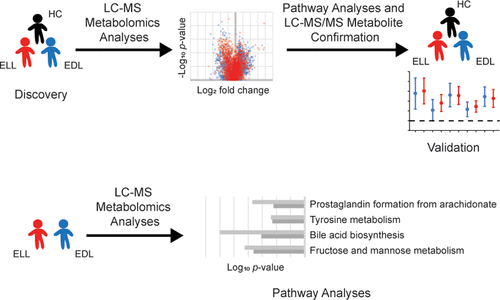当前位置:
X-MOL 学术
›
J. Proteome Res.
›
论文详情
Our official English website, www.x-mol.net, welcomes your feedback! (Note: you will need to create a separate account there.)
Host Metabolic Response in Early Lyme Disease.
Journal of Proteome Research ( IF 4.4 ) Pub Date : 2020-01-09 , DOI: 10.1021/acs.jproteome.9b00470 Bryna L Fitzgerald 1 , Claudia R Molins 1 , M Nurul Islam 2 , Barbara Graham 2 , Petronella R Hove 2 , Gary P Wormser 3 , Linden Hu 4 , Laura V Ashton 1 , John T Belisle 2
Journal of Proteome Research ( IF 4.4 ) Pub Date : 2020-01-09 , DOI: 10.1021/acs.jproteome.9b00470 Bryna L Fitzgerald 1 , Claudia R Molins 1 , M Nurul Islam 2 , Barbara Graham 2 , Petronella R Hove 2 , Gary P Wormser 3 , Linden Hu 4 , Laura V Ashton 1 , John T Belisle 2
Affiliation

|
Lyme disease is a tick-borne bacterial illness that occurs in areas of North America, Europe, and Asia. Early infection typically presents as generalized symptoms with an erythema migrans (EM) skin lesion. Dissemination of the pathogen Borrelia burgdorferi can result in multiple EM skin lesions or in extracutaneous manifestations such as Lyme neuroborreliosis. Metabolic biosignatures of patients with early Lyme disease can potentially provide diagnostic targets as well as highlight metabolic pathways that contribute to pathogenesis. Sera from well-characterized patients diagnosed with either early localized Lyme disease (ELL) or early disseminated Lyme disease (EDL), plus healthy controls (HC), from the United States were analyzed by liquid chromatography-mass spectrometry (LC-MS). Comparative analyses were performed between ELL, or EDL, or ELL combined with EDL, and the HC to develop biosignatures present in early Lyme disease. A direct comparison between ELL and EDL was also performed to develop a biosignature for stages of early Lyme disease. Metabolic pathway analysis and chemical identification of metabolites with LC-tandem mass spectrometry (LC-MS/MS) demonstrated alterations of eicosanoid, bile acid, sphingolipid, glycerophospholipid, and acylcarnitine metabolic pathways during early Lyme disease. These metabolic alterations were confirmed using a separate set of serum samples for validation. The findings demonstrated that infection of humans with B. burgdorferi alters defined metabolic pathways that are associated with inflammatory responses, liver function, lipid metabolism, and mitochondrial function. Additionally, the data provide evidence that metabolic pathways can be used to mark the progression of early Lyme disease.
中文翻译:

早期莱姆病的宿主代谢反应。
莱姆病是由tick传播的细菌性疾病,发生在北美,欧洲和亚洲地区。早期感染通常表现为泛红斑(EM)皮肤病变的普遍症状。病原体伯氏疏螺旋体的传播可导致多种EM皮肤损伤或皮肤外表现,例如莱姆神经疏螺旋体病。早期莱姆病患者的代谢生物特征可以潜在地提供诊断目标,并突出有助于发病机理的代谢途径。通过液相色谱-质谱法(LC-MS)分析来自美国的特征明确的患者,这些患者被诊断出患有早期局部莱姆病(ELL)或早期弥散性莱姆病(EDL)以及健康对照(HC)。在ELL或EDL之间进行了比较分析,或ELL与EDL结合使用,以及HC可以发展出早期莱姆病的生物特征。还对ELL和EDL进行了直接比较,以开发早期莱姆病疾病的生物特征。液相色谱串联质谱(LC-MS / MS)的代谢途径分析和代谢物的化学鉴定显示了莱姆病早期期间类花生酸,胆汁酸,鞘脂,甘油磷脂和酰基肉碱代谢途径的改变。使用另一组血清样品进行确认,确认了这些代谢改变。研究结果表明,感染伯氏疏螺旋体的人会改变与炎症反应,肝功能,脂质代谢和线粒体功能相关的明确代谢途径。此外,
更新日期:2020-01-09
中文翻译:

早期莱姆病的宿主代谢反应。
莱姆病是由tick传播的细菌性疾病,发生在北美,欧洲和亚洲地区。早期感染通常表现为泛红斑(EM)皮肤病变的普遍症状。病原体伯氏疏螺旋体的传播可导致多种EM皮肤损伤或皮肤外表现,例如莱姆神经疏螺旋体病。早期莱姆病患者的代谢生物特征可以潜在地提供诊断目标,并突出有助于发病机理的代谢途径。通过液相色谱-质谱法(LC-MS)分析来自美国的特征明确的患者,这些患者被诊断出患有早期局部莱姆病(ELL)或早期弥散性莱姆病(EDL)以及健康对照(HC)。在ELL或EDL之间进行了比较分析,或ELL与EDL结合使用,以及HC可以发展出早期莱姆病的生物特征。还对ELL和EDL进行了直接比较,以开发早期莱姆病疾病的生物特征。液相色谱串联质谱(LC-MS / MS)的代谢途径分析和代谢物的化学鉴定显示了莱姆病早期期间类花生酸,胆汁酸,鞘脂,甘油磷脂和酰基肉碱代谢途径的改变。使用另一组血清样品进行确认,确认了这些代谢改变。研究结果表明,感染伯氏疏螺旋体的人会改变与炎症反应,肝功能,脂质代谢和线粒体功能相关的明确代谢途径。此外,


























 京公网安备 11010802027423号
京公网安备 11010802027423号